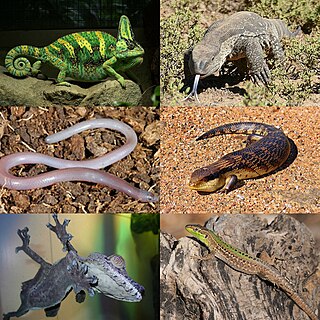
Lizard is the common name used for all squamate reptiles other than snakes, encompassing over 7,000 species, ranging across all continents except Antarctica, as well as most oceanic island chains. The grouping is paraphyletic as some lizards are more closely related to snakes than they are to other lizards. Lizards range in size from chameleons and geckos a few centimeters long to the 3-meter-long Komodo dragon.

The Iguanidae is a family of lizards composed of the iguanas, chuckwallas, and their prehistoric relatives, including the widespread green iguana.
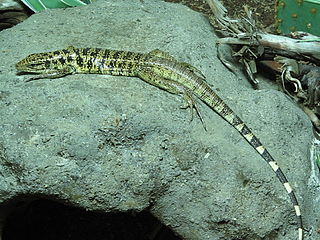
Teiidae is a family of autarchoglossan lizards native to the Americas. Members of this family are generally known as whiptails or racerunners; however, tegus also belong to this family. Teiidae is sister to the Gymnopthalmidae, and both families comprise the Teiioidea. The Teiidae includes several parthenogenic species – a mode of clonal reproduction. Presently, the Teiidae consists of approximately 150 species in eighteen genera.
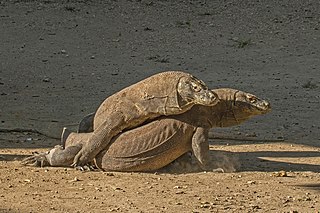
The Varanidae are a family of lizards in the superfamily Varanoidea and order Anguimorpha. The family, a group of carnivorous and frugivorous lizards, includes the living genus Varanus and a number of extinct genera more closely related to Varanus than to the earless monitor lizard (Lanthanotus). Varanus includes the Komodo dragon, crocodile monitor, savannah monitor, the goannas of Australia and Southeast Asia, and various other species with a similarly distinctive appearance. Their closest living relatives are the earless monitor lizard and chinese crocodile lizard. The oldest members of the family are known from the Late Cretaceous of Mongolia.

Skinks are lizards belonging to the family Scincidae, a family in the infraorder Scincomorpha. With more than 1,500 described species across 100 different taxonomic genera, the family Scincidae is one of the most diverse families of lizards. Skinks are characterized by their smaller legs in comparison to typical lizards and are found in different habitats except arctic and subarctic regions.
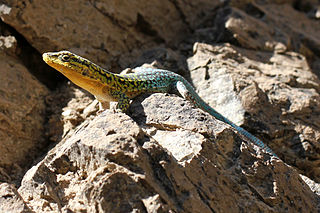
Liolaemus is a genus of iguanian lizards, containing many species, all of which are endemic to South America.

Phymaturus is a genus of iguanian lizards of the family Liolaemidae, a family which was traditionally included in the Iguanidae as a subfamily, but more recently was proposed to warrant family status in the Liolaemidae. Phymaturus is the mid-sized genus of its family, with 50 species altogether known as of 2021; new species are still being discovered, however.

Anolis is a genus of anoles, iguanian lizards in the family Dactyloidae, native to the Americas. With more than 425 species, it represents the world's most species-rich amniote tetrapod genus, although many of these have been proposed to be moved to other genera, in which case only about 45 Anolis species remain. Previously, it was classified under the family Polychrotidae that contained all the anoles, as well as Polychrus, but recent studies place it in the Dactyloidae.

Toxicofera is a proposed clade of scaled reptiles (squamates) that includes the Serpentes (snakes), Anguimorpha and Iguania. Toxicofera contains about 4,600 species, of extant Squamata. It encompasses all venomous reptile species, as well as numerous related non-venomous species. There is little morphological evidence to support this grouping; however, it has been recovered by all molecular analyses as of 2012.
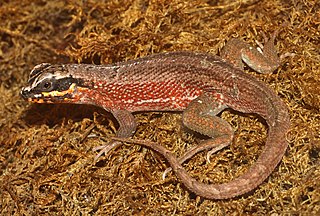
Iguania is an infraorder of squamate reptiles that includes iguanas, chameleons, agamids, and New World lizards like anoles and phrynosomatids. Using morphological features as a guide to evolutionary relationships, the Iguania are believed to form the sister group to the remainder of the Squamata, which comprise nearly 11,000 named species, roughly 2000 of which are iguanians. However, molecular information has placed Iguania well within the Squamata as sister taxa to the Anguimorpha and closely related to snakes. The order has been under debate and revisions after being classified by Charles Lewis Camp in 1923 due to difficulties finding adequate synapomorphic morphological characteristics. Most Iguanias are arboreal but there are several terrestrial groups. They usually have primitive fleshy, non-prehensile tongues, although the tongue is highly modified in chameleons. Today they are scattered occurring in Madagascar, the Fiji and Friendly Islands and Western Hemisphere.
Liolaemus gravenhorstii, commonly known as Gravenhorst's tree iguana, is a species of lizard in the family Liolaemidae. The species is endemic to South America.

The Italian wall lizard or ruin lizard is a species of lizard in the family Lacertidae. P. siculus is native to south and southeastern Europe, but has also been introduced elsewhere in the continent, as well as North America, where it is a possible invasive species. P. siculus is a habitat generalist and can thrive in natural and human-modified environments. Similarly, P. siculus has a generalized diet as well, allowing it to have its large range.

The Northern Sierra Madre forest monitor, also known by the local names bitatawa, baritatawa, and butikaw, is a large, arboreal, frugivorous lizard of the genus Varanus. The lizard is a distinctive food of the Aeta and Ilongot indigenous people of the Philippines.

Liolaemus chiliensis is a species of lizard in the family Liolaemidae, also referred to as the weeping or crying lizard in English. Synonyms for this species include Liodeira chilensis and Calotes chiliensis. Less commonly, it is called the Talcahuano Smooth-throated Lizard.

Liolaemus fabiani, also known commonly as Fabian's lizard, Yanez's tree iguana, and lagartija de Fabián in Spanish, is a species of lizard in the family Liolaemidae. The species is native to Chile.

The Lacertoidea is a group of squamate reptiles that includes the Lacertidae, Teiidae, Gymnophthalmidae, and Amphisbaenia. The finding from molecular phylogenetic studies that the burrowing Amphisbaenia were nested in a clade with the lizard forms led Vidal & Hedges (2005) to propose a new name for the group based on shared morphogical characters, Laterata, "referring to the presence of tile-like scales that form the rings in Amphisbaenia, and are also present ventrally in Lacertiformata and Teiformata".

Venom in snakes and some lizards is a form of saliva that has been modified into venom over its evolutionary history. In snakes, venom has evolved to kill or subdue prey, as well as to perform other diet-related functions. While snakes occasionally use their venom in self defense, this is not believed to have had a strong effect on venom evolution. The evolution of venom is thought to be responsible for the enormous expansion of snakes across the globe.
Uquiasaurus is an extinct genus of iguanian lizards represented by the type species Uquiasaurus heptanodonta from the Late Pliocene of Argentina. Uquiasaurus was first described in 2012 on the basis of isolated snout and jaw bones within the Uquía Formation, the namesake of the genus. These bones were preserved in a midden of predatory bird pellets and are part of a microvertebrate assemblage that includes the bones of rodents, marsupials, frogs, birds, and other lizards, one of the few to document the mixing of North and South American faunas during the Great American Interchange. Phylogenetic analysis indicates that Uquiasaurus is part of a clade of iguanians that includes the living families Liolaemidae, Leiocephalidae, and Tropiduridae. The status of U. heptanodonta as a valid taxon was contested by Scanferla & Díaz-Fernández (2023), who reinterpreted the type series of this species as a fossil bone assemblage composed by more than one species of Liolaemus. Below is a cladogram from Daza et al. (2012) showing its phylogenetic relationships:
Liolaemus cazianiae is a species of lizard in the family Liolaemidae. The species is endemic to Argentina.
Liolaemus gununakuna is a species of lizard in the family Liolaemidae. The species is endemic to Argentina.
















